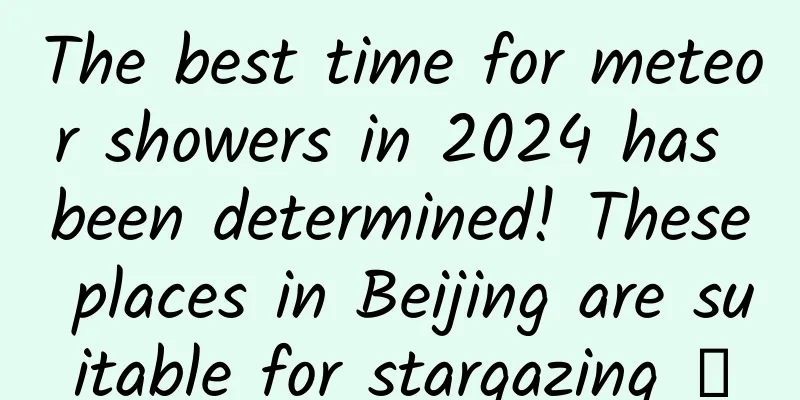The best time for meteor showers in 2024 has been determined! These places in Beijing are suitable for stargazing →

|
The year-end astronomical feast, the Geminid meteor shower will reach its peak on December 14. Meteor shower enthusiasts can observe it from the night of the 13th to the early morning of the 14th and try to make a New Year's wish. Geminid meteor shower (multiple superposition) captured at Lugu Lake in Yunnan from the night of December 13 to the early morning of December 14, 2023. (Photo by Bai Maolin, courtesy of Starlink CSVA) It is understood that meteors are light trails formed by dust and debris in interplanetary space passing quickly through the Earth's atmosphere. These dust and debris are called "meteoroids." Meteor showers are light trails formed by meteoroids with the same orbit breaking into the atmosphere in a short period of time. These meteoroids usually come from comets, but some asteroids are also active and throw out dust and debris in orbit, thus creating exceptions like the Geminids, a meteor shower brought by an asteroid. Wang Kechao, director of science popularization at the Purple Mountain Observatory of the Chinese Academy of Sciences, said that the parent body of the meteor shower we are about to see is an asteroid named Phaethon. Phaethon, discovered in 1983, is a gyro-shaped asteroid with an effective diameter of about 5.7 kilometers, a rotation period of about 3.6 hours, and a period of about 523.5 days around the sun. It is an Apollo-type asteroid. Its surface is an unusual blue, and its surface composition may be dehydrated rock minerals. "Phaethon's eccentricity is about 0.89, which means that its orbit around the sun is a very flat ellipse, which makes its perihelion very close to the sun, only 0.14 astronomical units, closer to the sun than the average asteroid." Wang Kechao said that when Phaethon was at perihelion, it was baked by the sun, making it active and throwing out dust in its orbit. Jiang Chenming, co-founder of CSVA, said that meteor showers occur regularly and tend to recur on roughly the same days every year, so they are also called "periodic meteor showers." For example, the Geminid meteor shower is usually active from December 4 to 17 every year. A fireball photographed in Bulaotun Town, Miyun, Beijing on December 13, 2022. (Photo by Xu Xiaoping, courtesy of Starlink CSVA) The Quadrantids, Perseids and Geminids are known as the three major meteor showers in the Northern Hemisphere, and they come on time every year. Because their radiant points are all located in the northern celestial hemisphere, they are more suitable for observation in the northern hemisphere. Among them, the Geminids are known for their "large flow rate", and their ZHR (Zenithalhourlyrate, which means "zenithal flow rate per hour", that is, assuming that the radiant point is at the zenith, the number of meteors that can be observed per hour throughout the day) can exceed 120. Its meteoroid speed is also relatively slow, about 35 km/s, which is determined by the angle between the dust ball orbit and the Earth's orbit. The slow meteoroid speed means that most meteors are relatively slow, which is relatively more conducive to photographic observation. Moreover, the Geminid meteor shower is white in color, has many bright meteors, and often has fireballs. Therefore, it has become the "box office guarantee" of the "Starry Sky Theater" at the end of each year and is also known as the "most trustworthy meteor shower." Astronomical forecasts show that this year's Geminid meteor shower will reach its peak around 9 a.m. on December 14, so the night of the 13th to the early morning of the 14th is best for observation. Gemini meteor shower (multiple superpositions) captured at Nianhu Lake in Yunnan from the night of December 13 to the early morning of December 14, 2023. (Photo by Luo Hongyang, courtesy of Starlink CSVA) Unfortunately, the Geminids this year will come on the 13th day of the lunar calendar, when the moon is nearly full, and will be in the Taurus constellation, very close to the radiant point. Not only will the moon be dim, but some fainter meteors will also be difficult to observe. Those who plan to observe the meteor shower can choose to avoid the moonlight in the second half of the night when the moon sets in the west, and observe towards the east to see more meteors. Geminid meteor shower (multiple superpositions) captured in Fengning, Hebei from the night of December 13 to the early morning of December 14, 2021. (Photo by Jiang Chenming, courtesy of Starlink CSVA) In the early morning of December 14, the moon will pass in front of the Pleiades, stole the show from the Geminid meteor shower. Recommended stargazing spots in Beijing Da'an Mountain: Da'an Mountain is located at the junction of Fangshan District and Mentougou District. It is a branch of Taihang Mountain. Its branch peaks include Baihua Mountain and Baicaopan. There is an open and flat area in the mountain surrounded by mountains on all sides, which is commonly known as "Beidaliang", and it is a scenic spot. Labagoumen Manchu Township: "Use your mobile phone to take photos of Beidou and watch the stars with naked eyes". Located in the northernmost part of Beijing, Labagoumen Manchu Township in Huairou has unique stargazing conditions. It is far away from the interference of urban lights and belongs to the third level of the 9-level dark sky classification system of Porter. There is very little light pollution, forming a unique dark night advantage and providing first-class stargazing conditions. Huahai Tianyuan Astronomical Farm: Beijing Huahai Tianyuan Astronomical Farm is located in Yanqing District, Beijing. It is one of the "Recommended Starry Sky Destination Cases of 2023". It is above 600 meters above sea level, with no high-altitude buildings nearby and only slight light pollution. The North Star can be clearly seen. The maximum magnitude here can reach 5 or above. Not only can you observe the starry sky through an astronomical telescope, you can also use a camera to record beautiful celestial bodies and enjoy a touch of tranquility in the vast starry sky. For most people, the best way is to watch it with your naked eyes. Because any telescope will reduce your field of view and miss many meteors. It is best to find a safe place away from urban light pollution and lie on a recliner or moisture-proof mat to watch the meteor shower. You don't need to just stare at the radiant point to watch the meteor shower. When the radiant point rises higher, you may see meteors in any direction. However, when the Geminid meteor shower is active, it is already midwinter in most parts of my country. If you want to observe the meteor shower outdoors for a long time, you must keep warm. Source: Xinhua News Agency, Tadpole Music, Beijing Tourism |
<<: Patrick tells us that it’s okay to evolve to have heads all over the body…
>>: Known as the "giant panda" among birds, it has a "pipa face"...
Recommend
Ji Zhongzhan: 13 Quick Winning Lessons in the Workplace Your Boss Won't Tell You
Course Catalog: Lesson 1-Is it better to work in ...
What does the bank do when you withdraw money from an ATM?
If you take an ICBC card to a CCB ATM and withdraw...
How to create a hit on Douyin?
In July this year, the official TikTok revealed a...
District 9 watch online free version, District 9 full movie!
In 1990, a huge spaceship appeared in the sky abo...
Industry and academia work together to build a better future - Honda successfully held a lecture on automobile styling design and drawing
On April 14 and 15, the 2018 Honda Industry-Unive...
Mechanical enterprise station optimization process sharing [Mold temperature controller]
Since most readers are building corporate website...
What is Web Hosting? What are the advantages and disadvantages of shared hosting?
After the website is completed, where should it b...
How can product operations achieve the goal of adding new users and retaining users?
We have heard many summaries of user growth and m...
All Tibetan areas in Sichuan have been lifted out of poverty! How did the local government do it?
On February 18, the Sichuan Provincial Government...
The "Top Ten Product Traps" Often Ignored When Planning Promotion
Introduction丨If you don’t understand product plan...
The human brain has billions of neurons, so why does it only run at 10 bits per second?
Produced by: Science Popularization China Author:...
Why is "Airbus" a Chinese scam that fooled many media outlets?
If I tell you that a technological invention that...
Understand these "skins": What are the differences between cold skin, rice skin, and rolled noodle skin?
The annual midsummer has arrived on time. In this...
It takes hundreds of tools to operate and plan an event!
When I first started operating , I was completely...
What are the current status of the seeds from Hangzhou that returned from space? The regular guests at your dinner table may have "cosmic genes"
Space fans are very excited recently. It has been...









